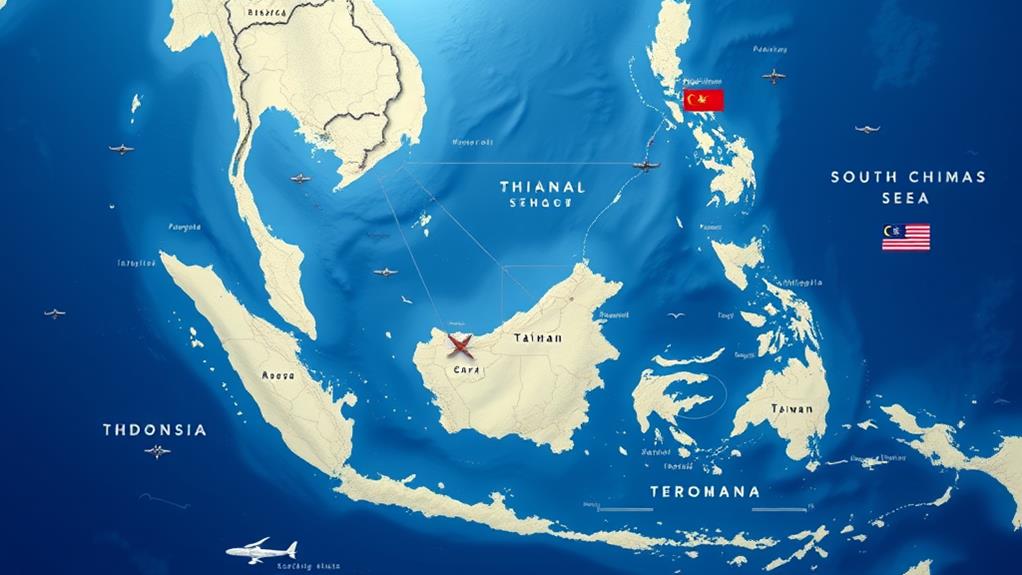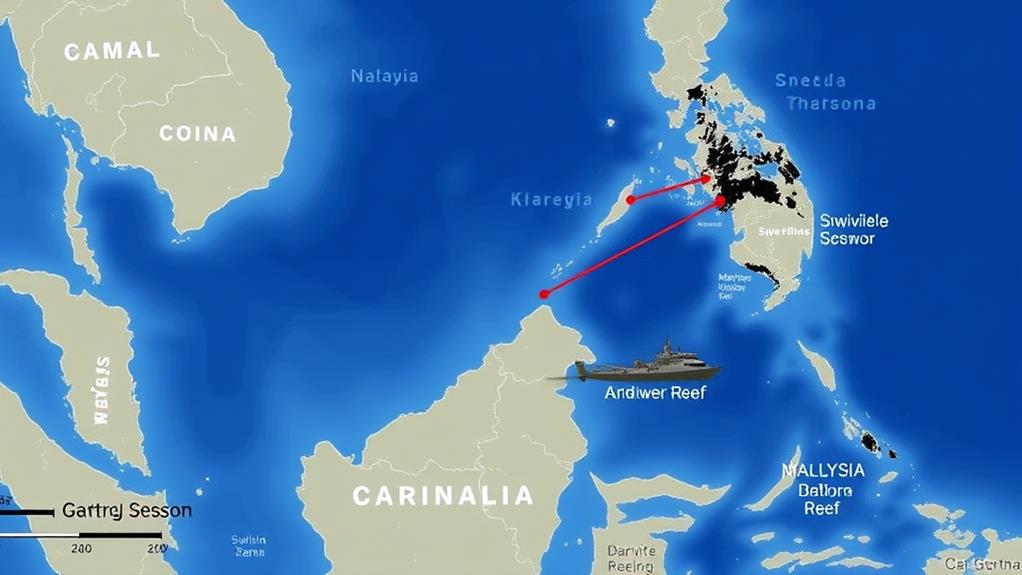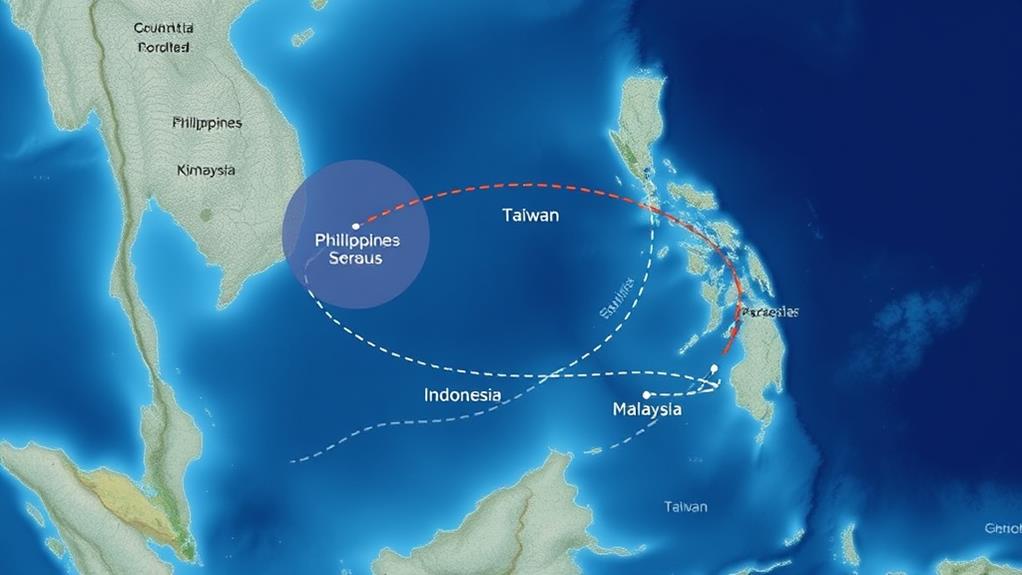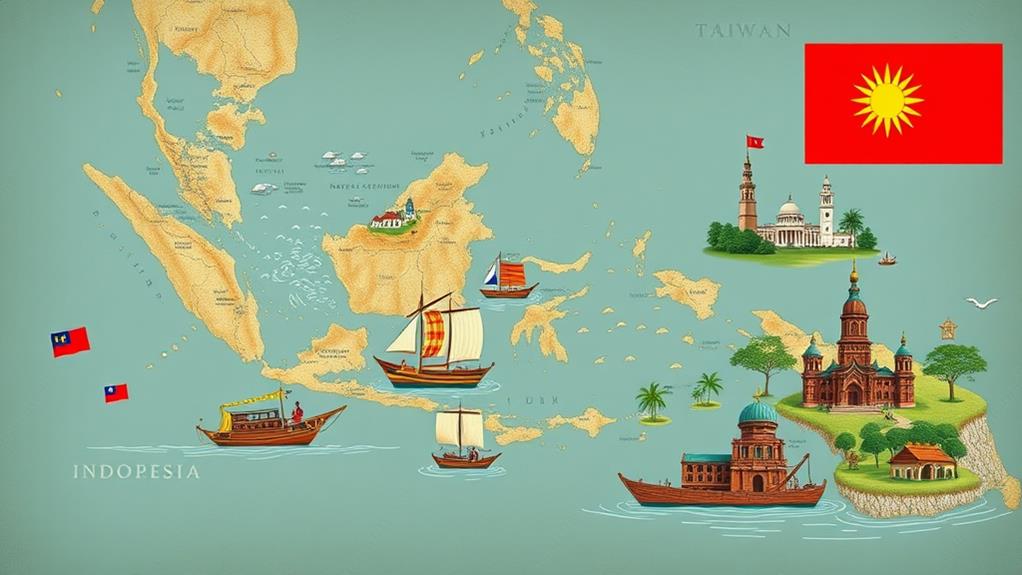The Philippines is strategically located in the Indo-Pacific region, where it shares significant connections with its neighboring countries, Indonesia, Malaysia, and Taiwan.
These nations are all navigating China's growing influence in the South China Sea.
Indonesia and Malaysia face territorial disputes with China due to its nine-dash line, which overlaps with their claims around the Natuna Islands and the Spratly Islands, respectively.
Taiwan, on the other hand, is challenged by China's increasing military presence, which questions Taiwan's sovereignty.
The Philippines plays a crucial role in maintaining regional stability amidst these tensions.
Historically and culturally, these nations share Austronesian ancestry and have engaged in maritime trade for centuries.
Today, they are increasingly reliant on partnerships with the United States to counterbalance Chinese actions.
This complex web of economic, security, and cultural dynamics binds these nations together in the Indo-Pacific region.
Philippines' Strategic Location

The Philippines' Strategic Location
The Philippines occupies a critical position in the Indo-Pacific region, situated at the heart of a highly contested area.
To the west lies the South China Sea, and to the east lies the Pacific Ocean, placing the country within the first island chain, just south of Taiwan. This strategic placement makes the Philippines a crucial player in regional security dynamics.
The South China Sea is a Focal Point of Tension
The South China Sea, also known as the West Philippine Sea, is a vital waterway due to its significance in international trade and security.
China's aggressive actions in the area have made it a focal point of tension, and the Philippines' presence here is crucial in maintaining regional stability.
A Key Partner for Other Nations
The Philippines' strategic location makes it an essential partner for other nations.
The United States, Japan, and Australia have strengthened their ties with the Philippines to counterbalance China's growing influence.
The recent formation of a US-Japan-Philippines triad underscores the Philippines' importance in maintaining regional stability and defending against potential Chinese aggression.
Indonesia's EEZ Disputes
Indonesia's EEZ Disputes: A Delicate Balance
Indonesia's Exclusive Economic Zone (EEZ) disputes are a critical aspect of its maritime policy.
The country's EEZ overlaps with China's "nine-dash line" claim, leading to frequent tensions, particularly around the Natuna Islands. This region is historically significant as a trade route, which further complicates maritime interactions.
In 2021, China demanded that Indonesia stop drilling for oil and gas in the overlap areas, escalating the situation. Indonesia has also had disputes with Vietnam over overlapping EEZ claims in the North Natuna Sea.
However, after 12 years of negotiations, they signed an agreement in December 2022 to demarcate their EEZ boundaries, resolving long-standing issues related to illegal fishing and enhancing bilateral cooperation.
Despite these regional agreements, Indonesia remains cautious in its approach to China, avoiding direct confrontation and relying on diplomatic efforts and regional alliances to protect its maritime interests. This delicate balance underscores the complexity of Indonesia's EEZ disputes and its efforts to maintain sovereignty while fostering regional cooperation.
Malaysia's Territorial Claims

Malaysia's Territorial Claims in the South China Sea
Malaysia's territorial claims in the South China Sea are complex due to overlapping claims with China's nine-dash line.
Malaysia asserts its rights over a portion of the South China Sea north of Borneo, encompassing at least 12 features in the Spratly Islands. Specifically, Malaysia controls Swallow Reef and claims Amboyna Cay, which is occupied by Vietnam.
Geopolitical Significance
The region is rich in natural resources, making it geopolitically significant.
Malaysia's claims are based on a 1966 law, a 1979 map, and a 2009 joint submission with Vietnam to the Commission on the Limits of the Continental Shelf.
Physical Presence and Maritime Territory
Malaysia has maintained a physical presence on five features: Pulau Layang-Layang (Swallow Reef), Terumbu Mantanani (Mariveles Reef), Terumbu Ubi (Ardasier Reef), Terumbu Siput (Erica Reef), and Terumbu Peninjau (Investigator Reef).
Malaysia's maritime territory is rich in oil and natural gas reserves, a critical income source for the country.
Resolution and International Law
Despite Chinese assertiveness and the nine-dash line, Malaysia rejects these claims, advocating for a resolution through dialogue and international law, specifically the 1982 United Nations Convention on the Law of the Sea (UNCLOS).
Taiwan's Sovereignty Challenges
Taiwan faces significant sovereignty challenges, particularly in the South China Sea region.
Geopolitical Tensions: Taiwan's sovereignty is threatened by China's assertive actions in the South China Sea, which can escalate into a regional crisis.
For instance, China's military bases and naval operations in the area indirectly pressure Taiwan by controlling vital sea lanes and threatening its security.
Maritime Claims: Taiwan's maritime claims, based on the 1947 ROC maritime chart, overlap with China's nine-dash line claims.
This overlap complicates diplomatic negotiations, making it challenging for Taiwan to assert its sovereignty.
Economic Vulnerability: Taiwan relies heavily on the South China Sea for trade and energy imports, making it vulnerable to potential blockades by China.
This vulnerability highlights the need for international support to ensure Taiwan's economic security.
Diplomatic Isolation: Despite advocating for a peaceful resolution and adherence to international law, Taiwan often finds itself isolated in regional forums.
It is crucial for Taiwan to engage in multilateral consultations to overcome this isolation and protect its sovereignty.
These challenges underscore the delicate balance Taiwan must maintain to protect its sovereignty while navigating complex regional dynamics.
China's Nine-Dash Line Claims

China's Nine-Dash Line Claims in the South China Sea
China's nine-dash line claims in the South China Sea are a central issue in the region's geopolitical tensions. This ambiguous demarcation, first inscribed on a Chinese map in 1947, extends hundreds of miles south and east from China's Hainan province, encompassing nearly the entire South China Sea.
Key Claims and Disputes
The nine-dash line has sparked significant tensions with neighboring countries, who also stake claims on various islands and zones in the South China Sea.
China claims sovereignty over land parcels and adjacent waters, but its ambiguous claims, island-building, and naval patrols have raised concerns.
Vietnam disputes China's historical account, citing historical sovereignty over Paracels and Spratlys since the 17th Century.
The Philippines contests China's claim to Scarborough Shoal, citing geographical proximity to Spratly Islands.
The nine-dash line's lack of clear coordinates and ambiguous maritime claims continue to complicate international maritime law.
This has led to increased military activities and diplomatic strains in the region, with countries such as Malaysia and Brunei also staking claims in the South China Sea.
Regional Economic Interests
The South China Sea is a crucial hub for regional economic interests, with its waters rich in natural resources and serving as a vital trade route.
Free Trade Agreements have played a significant role in shaping the region's economic landscape. The Regional Comprehensive Economic Partnership (RCEP), signed in 2020, is the largest free trade agreement in history, covering 30% of the world's population and fostering economic collaboration among ASEAN members, Australia, China, Japan, New Zealand, and South Korea.
Economic Diversification efforts have also been instrumental in driving economic growth in the region. For instance, countries like Taiwan are diversifying their economic links with Southeast Asia, enhancing people-to-people exchanges and labor ties.
Southeast Asia accounts for the majority of Taiwan's migrant workers, particularly from Indonesia, the Philippines, and Vietnam.
Despite progress, Trade Barriers remain a significant challenge for ASEAN. Non-tariff barriers, government-mandated investment restrictions, and vast disparities in GDP per capita complicate economic integration and trade within the bloc.
The Post-Pandemic Recovery of Southeast Asia has been a coordinated regional effort. The COVID-19 pandemic severely impacted the region, but ASEAN countries have aligned their economic recovery strategies and maintained open trade routes, ensuring a cautious yet optimistic outlook for 2024.
Historical and Cultural Ties

Historical and Cultural Ties in the Philippines
The Philippines has strong historical and cultural ties with its neighboring countries, including Indonesia, Malaysia, and Taiwan. These ties have shaped the country's society and reflect a complex web of influences.
Historical and Cultural Ties Table
| Country | Historical and Cultural Ties |
|---|---|
| Indonesia | Shared Austronesian ancestry and maritime trade routes since the 9th century, resulting in cultural exchanges. |
| Malaysia | Cultural and political relations, with influences from the Malay world evident in language and traditions. |
| Taiwan | Migration and trade links, especially from Fujian and Guangdong, influencing language, architecture, and cuisine. |
| Common | Austronesian language family connections, with languages like Tagalog and Malay linked to Formosan languages spoken in Taiwan. |
Migration and Cultural Exchanges
The Philippines' history with its neighboring countries is marked by migrations, trade, and cultural exchanges. For example, Chinese settlement in the Philippines during the Spanish colonial period led to shared linguistic, religious, and cultural practices, such as the use of Minnan as a lingua franca among ethnic Chinese communities.
Influence on Daily Life
The historical links between the Philippines and its neighbors are evident in various aspects of daily life, including architecture, cuisine, language, and social customs. These influences have created a rich tapestry of cultural diversity in the region.
How does the relationship between the Philippines and its neighbors, Indonesia, Malaysia, and Taiwan, impact ASEAN regional security and cooperation?
The philippines and asean cooperation closely intertwine with their neighboring countries, Indonesia, Malaysia, and Taiwan, to ensure regional security. As the Philippines strengthens its ties with these nations, it contributes to enhancing ASEAN’s collective efforts in resolving conflicts and promoting stability within the region.
US Influence in the Region
US influence in the Philippines, which lasted from 1898 to 1946, profoundly shaped the country's social, economic, and political landscape. The American period introduced significant reforms, such as a universal education system taught in English, which immensely benefited the Filipino population by increasing their participation in business, education, and government sectors.
For instance, the education system enabled Filipinos to engage in professional fields and hold government positions, contributing to the growth of a local middle class.
However, this influence also came with challenges. Colonial Administration was a key aspect of US influence. The US established a colonial government that controlled the Philippines' political and economic affairs, imposing policies like "benevolent assimilation" under President McKinley.
This led to the setup of local governmental bodies but minimal land reform, exacerbating existing economic disparities. For example, the US government created local councils and mayors, but failed to redistribute land from wealthy elites to poor farmers, perpetuating income inequality.
Another crucial aspect was the Military Presence. The US military played a crucial role, especially during the Philippine-American War, where Filipinos resisted American rule.
This period saw intense conflict and substantial loss of life on both sides. The war resulted in the deaths of thousands of Filipinos and Americans, leaving deep scars on both nations.
The Economic Impact of US influence was also significant. The US exploited the Philippines' resources and used the country as a strategic military base.
Despite promises of eventual independence, Filipinos felt exploited and deceived by US intentions. For instance, the US extracted natural resources like sugar, tobacco, and hemp, while maintaining control over the Philippine economy.
Finally, the Cultural Legacy of US influence was complex. Americans introduced sanitation practices and improved health conditions, but their influence also led to criticisms of neocolonialism and an incomplete transition to full independence.
This cultural exchange resulted in both positive and negative outcomes. On the one hand, the US introduced modern sanitation systems, reducing the incidence of diseases. On the other hand, the imposition of American culture threatened the Philippines' rich cultural heritage, such as the Banaue Rice Terraces, which reflect the deep connections to land and tradition of indigenous peoples.
These factors contributed to a complex relationship between the US and the Philippines, with lasting impacts on the country's development.
Maritime Security Concerns

The Philippines' strategic location in the Asia-Pacific region raises significant maritime security concerns. The country is caught in the middle of a geopolitical tug-of-war, particularly in the South China Sea. China's assertive territorial claims and land reclamation efforts have heightened tensions with the Philippines, as well as other Southeast Asian states like Indonesia, Malaysia, and Taiwan.
The Philippines' maritime routes and resources are crucial in contemporary geopolitical dynamics. Historically, the Pasig River served as a vital artery for trade and communication, establishing Manila as a thriving economic center. Today, securing marine ecosystems and ensuring economic stability amidst maritime disputes is essential.
The Philippines' maritime disputes with China are multifaceted. The occupation of the Scarborough Shoal by China has led to a decrease in fish stocks, impacting the livelihood of Filipino fishermen and driving up illegal fishing activities. This has created law enforcement challenges, with multiple agencies having overlapping mandates and limited resources to collaborate effectively.
The Philippines plays a crucial role in regional maritime security dynamics. Its proximity to Taiwan and its longstanding alliance with the United States make it essential in maintaining regional stability.
Recent incidents, such as Chinese Coast Guard vessels harassing Philippine resupply missions, underscore the urgency of establishing a coordinated maritime security policy framework to protect the country's interests and ensure the sustainability of its marine ecosystems.
Questions and Answers
How Do Local Economies Benefit From Tourism Between the Philippines and Its Neighbors?
Tourism Between the Philippines and Its Neighbors Boosts Local Economies
When tourists visit the Philippines, their spending has a significant impact on local economies. Staying in small, locally-owned accommodations directly supports families and communities, as the money spent on lodging goes towards providing for their daily needs.
Additionally, buying handmade souvenirs and eating at restaurants serving local food increases local incomes, as the revenue generated from these sales stays within the community.
Furthermore, choosing local tour operators and participating in cultural events disperses tourist spending, creating jobs and stimulating economic growth in rural areas. This is because local tour operators often hire local guides, drivers, and other staff, providing employment opportunities that mightn't exist otherwise.
By participating in cultural events, tourists also support local artisans, performers, and vendors, contributing to the preservation of traditional practices and customs.
What Role Do Family Ties Play in Relations Between Taiwan and Southeast Asia?
Family ties play a crucial role in relations between Taiwan and Southeast Asia. This is evident in transnational marriages, where Taiwanese men often marry women from countries like Vietnam and Indonesia.
These marriages form families that bridge cultural and national boundaries, fostering social and economic exchanges that contribute to regional integration and cultural exchange. For instance, in Vietnam, there are over 70,000 Vietnamese women married to Taiwanese men, creating a strong bond between the two nations.
These family ties enhance people-to-people connectivity, shaping a new collective identity and strengthening community bonds.
How Do Environmental Challenges Impact Cooperation Among the Philippines, Indonesia, and Malaysia?
Cooperation among the Philippines, Indonesia, and Malaysia is crucial when addressing environmental challenges.
One significant issue that requires regional strategies is plastic pollution. ASEAN's Regional Action Plan for Combating Marine Debris is a prime example of such cooperation. This plan involves policy strengthening, capacity building, and private sector engagement to mitigate the impact of plastic waste and other environmental threats.
To manage waste effectively, these countries must work together to implement anti-pollution laws and share best practices.
This cooperation enables them to learn from each other and adopt effective strategies to reduce plastic waste. By doing so, they can minimize the negative impact of environmental challenges on their ecosystems and communities.
What Are the Implications of Southeast Asia's Stance on China's New Territorial Map?
Southeast Asia's stance on China's new territorial map is one of widespread objection. This is evident in the reactions of countries like the Philippines, Malaysia, and Vietnam, which reject the map, citing violations of international law and their own sovereignty.
For instance, the Philippines has disputed China's claims over the Scarborough Shoal, a disputed territory in the South China Sea. Similarly, Malaysia has expressed concerns over China's claims in the Spratly Islands, which overlap with its own claims.
Vietnam has also voiced opposition to China's map, which it sees as an infringement on its own territorial waters.
Taiwan also denies being part of China, further complicating the territorial disputes in the region.
The implications of these objections are far-reaching, with the potential to escalate tensions at regional summits like ASEAN and G20. This could complicate efforts to resolve disputes and potentially strain diplomatic relations between China and its Southeast Asian neighbors.
How Does the New Southbound Policy Affect Business Interactions Between Taiwan and Southeast Asia?
The New Southbound Policy strengthens business interactions between Taiwan and Southeast Asia. This policy promotes economic cooperation, talent exchanges, and resource sharing between Taiwan and Southeast Asia.
By reducing Taiwan's reliance on China, the policy fosters bilateral partnerships with ASEAN countries, boosting trade, investment, and cultural links.
For instance, Taiwanese companies are encouraged to invest in Southeast Asia, which enhances regional integration and supports a diversified economy.
This leads to new opportunities for growth and collaboration.